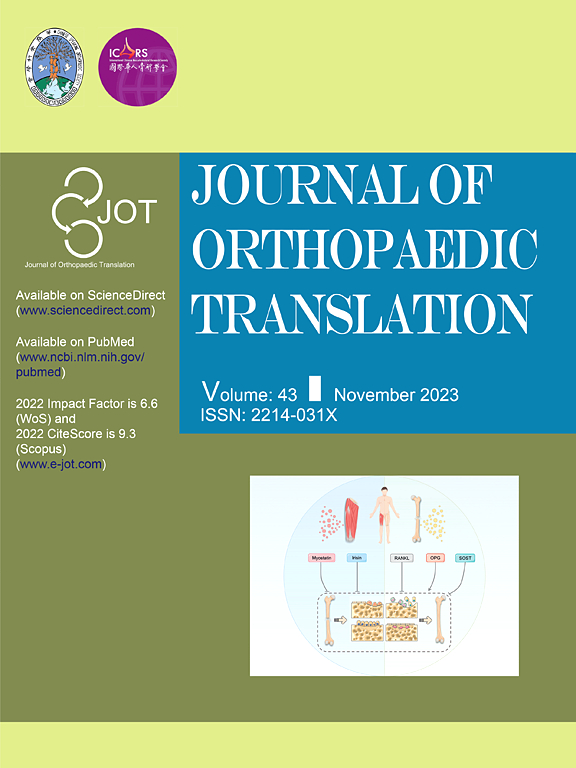MAGI1 attenuates osteoarthritis by regulating osteoclast fusion in subchondral bone through the RhoA-ROCK1 signaling pathway
IF 5.9
1区 医学
Q1 ORTHOPEDICS
引用次数: 0
Abstract
Background
Osteoarthritis (OA) is a chronic joint disorder that predominantly affects middle-aged or elderly individuals. Subchondral bone remodeling due to osteoclast hyperactivation is regarded as a major feature of early OA. During osteoclast fusion and multinucleation, the cytoskeleton reorganization leads to the formation of actin belts and ultimately bone resorption. Membrane-associated guanylate kinase with an inverted repeat member 1 (MAGI1) is a scaffolding protein that is crucial for linking the extracellular environment to intracellular signaling pathways and cytoskeleton. However, the role of MAGI1 in subchondral bone osteoclast fusion remains unclear.
Methods
In this study, we collected knee joint samples from OA patients and established the OA mouse model to examine the expression of MAGI1. Furthermore, we established the OA rat model and locally injected rAAV9-mediated shMagi1 into the subchondral bone to knock down MAGI1 expression. Micro-CT, histological staining, and immunofluorescence were employed to assess the effects of MAGI1 knockdown on subchondral bone homeostasis and OA process. We isolated and cultured osteoclasts from femoral and tibial bone marrow. Receptor activator of nuclear factor-κB ligand (RANKL)-stimulated osteoclasts served as an in vitro model for OA and underwent RNA sequencing. We employed gain- and loss-of-function experiments using MAGI1-overexpression plasmids and small interfering RNA to explore the role of MAGI1 in osteoclast differentiation. Further molecular experiments, including RT-qPCR, western blotting, immunofluorescence staining, and LC-MS/MS were performed to investigate underlying mechanisms.
Results
MAGI1 expression was significantly downregulated during RANKL-induced osteoclastogenesis in vitro. Additionally, a progressive decrease in MAGI1 expression was consistently observed in both knee joint samples from OA patients and mouse OA models, correlating with OA progression. Knockdown of MAGI1 in subchondral bone increased osteoclast numbers and worsened subchondral bone microarchitecture and cartilage degeneration; MAGI1 knockdown rats exhibited elevated PDGF-BB, Netrin-1, and CGRP+ sensory innervation. Overexpression and knockdown of MAGI1 suppressed and promoted osteoclast differentiation, respectively. Mechanistically, MAGI1 overexpression decreased the levels of RhoA, ROCK1, and p-p65 in RANKL-treated osteoclasts, which was rescued by the addition of RhoA activator narciclasine.
Conclusion
Our results demonstrate that MAGI1 suppresses osteoclast fusion through the RhoA/ROCK1 signaling pathway, targeting MAGI1 in subchondral bone osteoclasts may be a promising therapeutic strategy mitigate the advancement of OA.
The translational potential of this article
This study reveals that the scaffold protein MAGI1 participates in osteoarthritis progression by regulating osteoclast fusion, providing novel theoretical foundations and potential therapeutic targets for osteoarthritis treatment.

MAGI1通过RhoA-ROCK1信号通路调节软骨下骨破骨细胞融合,从而减轻骨关节炎
骨关节炎(OA)是一种慢性关节疾病,主要影响中老年人。破骨细胞过度活化导致的软骨下骨重塑被认为是早期OA的主要特征。在破骨细胞融合和多核过程中,细胞骨架重组导致肌动蛋白带的形成,最终导致骨吸收。具有倒置重复成员1的膜相关鸟苷酸激酶(MAGI1)是一种支架蛋白,对于连接细胞外环境与细胞内信号通路和细胞骨架至关重要。然而,MAGI1在软骨下破骨细胞融合中的作用尚不清楚。方法本研究收集OA患者膝关节标本,建立OA小鼠模型,检测MAGI1的表达。此外,我们建立OA大鼠模型,将raav9介导的shMagi1局部注射到软骨下骨,以降低MAGI1的表达。采用显微ct、组织学染色和免疫荧光技术评估MAGI1基因敲低对软骨下骨稳态和OA过程的影响。我们从股骨和胫骨骨髓中分离培养破骨细胞。核因子-κB配体受体激活因子(RANKL)刺激的破骨细胞作为OA的体外模型并进行RNA测序。我们使用mag1过表达质粒和小干扰RNA进行了功能增益和功能损失实验,以探索mag1在破骨细胞分化中的作用。进一步的分子实验,包括RT-qPCR、western blotting、免疫荧光染色和LC-MS/MS,以探讨其潜在的机制。结果在rankl诱导的体外破骨细胞形成过程中,smagi1的表达明显下调。此外,在OA患者和小鼠OA模型的膝关节样本中一致观察到MAGI1表达的进行性下降,与OA进展相关。软骨下骨组织中magig1表达下调,破骨细胞数量增加,软骨下骨微结构恶化,软骨退变;MAGI1敲除大鼠表现出PDGF-BB、Netrin-1和CGRP+感觉神经支配升高。MAGI1过表达和敲低分别抑制和促进破骨细胞分化。在机制上,MAGI1过表达降低了rankl处理的破骨细胞中RhoA、ROCK1和p-p65的水平,这是通过添加RhoA激活剂水仙碱来恢复的。结论magig1通过RhoA/ROCK1信号通路抑制破骨细胞融合,以软骨下骨破骨细胞为靶点可能是减缓骨性关节炎进展的一种有前景的治疗策略。本研究揭示了支架蛋白MAGI1通过调节破骨细胞融合参与骨关节炎的进展,为骨关节炎的治疗提供了新的理论基础和潜在的治疗靶点。
本文章由计算机程序翻译,如有差异,请以英文原文为准。
求助全文
约1分钟内获得全文
求助全文
来源期刊

Journal of Orthopaedic Translation
Medicine-Orthopedics and Sports Medicine
CiteScore
11.80
自引率
13.60%
发文量
91
审稿时长
29 days
期刊介绍:
The Journal of Orthopaedic Translation (JOT) is the official peer-reviewed, open access journal of the Chinese Speaking Orthopaedic Society (CSOS) and the International Chinese Musculoskeletal Research Society (ICMRS). It is published quarterly, in January, April, July and October, by Elsevier.
 求助内容:
求助内容: 应助结果提醒方式:
应助结果提醒方式:


